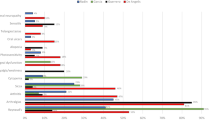Abstract
Connective tissue diseases (CTDs) are chronic multisystemic inflammatory disorders whose indicative signs or symptoms have a high sensitivity but poor specificity in predicting the evolution into a given CTD. We have analysed 84 consecutive patients initially diagnosed as having an early undifferentiated CTD (early UCTD) with the aim of verifying the evolution into one definite CTD and of evaluating the predictive value of clinical and laboratory parameters. During a 5-year study period, 33 patients developed signs of a full-blown CTD; the highest probability of evolution was in the first 48 months after the onset. Multivariate analysis allowed us to select those variables correlating with evolution into a particular CTD, such as sclerodactyly and oesophageal dysfunction for systemic sclerosis, xerostomia and anti-nuclear antibodies (SS-A pattern) for Sjögren's syndrome, and fever and anti-DNA antibodies for systemic lupus erythematosus. Further-more, we assessed the prevalence of various clinical and laboratory manifestations, complications and prognosis of those patients diagnosed after a 5-year disease duration period as having a UCTD. In our series, major organs such as the kidney or heart seem to be spared, whereas we detected a relatively high prevalence of endocrine disease of autoimmune origin.
Similar content being viewed by others
References
Arnett FC, Edworthy SM, Bloch DA, et al. The American Rheumatism Association 1987 revised criteria for the classification of rheumatoid arthritis. Arthritis Rheum 1988;31:315–24.
Tan EM, Cohen AS, Fries JF, et al. The 1982 revised criteria for the classification of systemic lupus erythematosus. Arthritis Rheum 1982;25:1271–7.
Subcommittee for scleroderma criteria of the ARA diagnostic and therapeutic criteria committee. Preliminary criteria for the classification of systemic sclerosis (scleroderma). Arthritis Rheum 1980;23:581–90.
Fox RI, Robinson CA, Curd JG, Kozin, F, Howell FV. Sjögren's syndrome. Proposed criteria for classification. Arthritis Rheum 1986;29:577–85.
Bohan A, Peter JB. Polymyositis and dermatomyositis. Part I. New Engl J Med 1975;292:344–7.
Bohan A, Peter JB. Polymyositis and dermatomyositis. Part II. New Engl J Med 1975;292:403–7.
Sharp GC. Diagnostic criteria for classification of MCTD. In: Kasukawa R, Sharp GC, editors. MCTD and anti-nuclear antibodies. Amsterdam: Elsevier, 1987:23–32.
Alarçon-Segovia D, Cardiel MA. Comparison between three diagnostic criteria for connective tissue disease: study of 593 patients. J Rheumatol 1989;16:328–34.
Alarcón GS, Williams GV, Singer JZ, Steen VD, et al. Early undifferentiated connective tissue disease: I. Early clinical manifestation in a large cohort of patients with undifferentiated connective tissue diseases compared with cohorts of well established connective tissue disease. J Rheumatol 1991; 18:1332–9.
Kallenberg CGM. Overlapping syndromes, undifferentiated connective tissue disease and other fibrosing conditions. Curr Op in Rheumatol 1995;7:568–73.
LeRoy CE. Raynaud's phenomenon, scleroderma, overlap syndromes, and other fibrosing conditions. Curr Opin Rheumatol 1992;4:821–4.
American Rheumatism Association Glossary Committee: Dictionary of the rheumatic diseases. New York: Contact Associates, 1982.
Carr RI, Hoffmann AE, Harbeck RJ. Comparison of DNA binding in normal population, general hospital laboratory personnel and personnel from laboratories studying SLE. J Rheumatol 1975;2:178–82.
Sequi J, Leigh I, Isenberg DA. Relation between antinuclear antibodies and the autoimmune rheumatic diseases and disease type and activity in SLE using a variety of cultured cell lines. Ann Rheum Dis 1991;50:167–72.
Galen RS, Gambino SR. Beyond normality. New York: John Wiley, 1975.
Vayssairat M, Baudot N, Gaitz JP. Raynaud's phenomenon together with antinuclear antibodies: a common subset of incomplete connective tissue disease. J Am Acad Dermatol 1995;32:747–9.
Gerbracht DD, Steen VD, Ziegler GL, Medsger TA, Rodnan GP. Evolution of primary Raynaud's phenomenon (Raynaud's disease) to connective tissue disease. Arthritis Rheum 1985; 28:87–92.
Kallenberg CGM, Wouda AA, Hoet MH, van Venrooij WJ. Development of connective tissue disease in patients with Raynaud's phenomenon: a six year follow up with emphasis on the predictive value of antinuclear antibodies as detected by immunoblotting. Ann Rheum Dis 1988;47:634–41.
Harper FE, Maricq HR, Turner RE, et al. A prospective study of Raynaud phenomenon and early connective tissue disease. Am J Med 1982;72:883–8.
Wollersheim H, Thien TH, Hoet MH, van Venrooi WJ. The diagnostic value of several immunological tests for anti-nuclear antibody in predicting the development of connective tissue disease in patients presenting with Raynaud's phenomenon. Eur J Clin Invest 1989;19:535–41.
Ganczarczyk L, Urowitz MB, Gladman DD. Latent lupus. J Rheumatol 1991;16:475–8.
Alarcón GS, Wilkens RF, Singer JZ, Ward JR, et al. Early undifferentiated connective tissue disease: IV. Muscoloskeletal manifestations in a large cohort of patients with undifferentiated connective tissue diseases compared with cohorts of well established connective tissue disease: follow-up analyses in patients with unexplained polyarthritis and patients with rheumatoid arthritis at baseline. Arthritis Rheum 1996;39:403–14.
Clegg DO, Williams GV, Singer JZ, et al. Early undifferentiated connective tissue disease: II. The frequency of circulating antinuclear antibodies in patients with early rheumatic diseases. J Rheumatol 1991;18:1340–3.
Houtman PM, Kallenberg CGM, Limburg PC, et al. Quantitation of antibodies to ribonucleoprotein by ELISA. Relation between antibody levels and disease activity in patients with connective tissue disease. Clin Exp Immunol 1985;62:696–701.
Harley JB, Alexander EL, Bias WB, et al. Anti-Ro (SS-A) and anti-La (SS-B) in patients with Sjögren's syndrome. Arthritis Rheum 1986;29:196–206.
Brinkman K, Termaat R, Berden JHM, Smeenk RJT. Anti-DNA antibodies and lupus nephritis: the complexity of cross-reactivity. Immunol Today 1990;11:232–4.
Santana V, Rose NL. Neoplastic lymphoproliferation in autoimmune disease: an updated review. Clin Immunol Immunopathol 1992;63:205–13.
Lundberg I, Hedfors E. Clinical course of patients with anti-RNP antibodies. A prospective study of 32 patients. J Rheumatol 1991;18:1511–9.
Author information
Authors and Affiliations
Corresponding author
Rights and permissions
About this article
Cite this article
Danieli, M.G., Fraticelli, P., Salvi, A. et al. Undifferentiated connective tissue disease: Natural history and evolution into definite CTD assessed in 84 patients initially diagnosed as early UCTD. Clin Rheumatol 17, 195–201 (1998). https://doi.org/10.1007/BF01451046
Received:
Accepted:
Issue Date:
DOI: https://doi.org/10.1007/BF01451046




